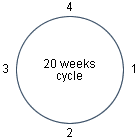However, we have recently “discovered” a new BM option that opens the door to new possibilities. It is a system that fulfills a large part of the pros, minimizes the cons, and can turn out to be rather attractive to farms where the “traditional” systems haven’t been successful. We call this the Ideal Batch.
The different BM systems that last over a week offer great advantages: better sanitary stability and disease control, improved work distribution and grouping, batches with a higher number of animals.
However, they also generate a series of cons:
1.
Increased difficulty in fulfilling forecast farrowing objectives.
2.
What do we do with the sows that are mated “out of turn”?
3.
Increased difficulty forming fostering sows
4.
Rotation times for the pens imposed by the type of BM.
Farrowing pen rotation with BM
As opposed to with weekly batches, the batches that last more than one week impose a certain rotation of farrowing pens:
The 4-week rotations take the most advantage of the maternity slots, but at the cost of forced early weaning (maximum 21 days), and offer a limited time for sanitation and the entrance of pre-farrowing sows (1 week). In this situation, the sows in the batch that are slightly advanced compromise sanitation and the all in - all out management strategy, while the delayed sows have to be weaned after a decreased lactation period (less than 21 days).·
With BM every 2 weeks and every 4 weeks, a rotation every 4 weeks is necessary.
·
With BM every 5 weeks, a rotation ever 5 weeks is necessary.
·
With BM every 3 weeks, a rotation every 6 weeks is necessary.
The 6-week rotations are the extreme opposite. The allow for weaning at 28 days with 2 weeks left for sanitation and the entrance of sows. The sows that are advanced by up to one week can give birth without compromising sanitation and the sows that are delayed up to a week can be reincorporated into the batch, weaning at 21 days in the next lactation period. They are very flexible rotations, but they excessively penalize the productive capacity of the maternity pens.
In the middle we can find the 5-week rotation. Just like in the 6-week rotations, they allow for weaning at 28 days, although this means less (although sufficient) time for sanitation and the entrance of sows (1 week). This way, we can take advantage of the maternity slots more so than with the 6-week rotations, but less so than with the 4-week rotations. We could say that it is just right (not too much, not too little).
Example: Farm with 120 maternity slots
| Loss of 2/6 production = 33,3 % |  |
|
|
As we can see, a farm that decides to go from a 4-week rotation to a 6-week rotation should reduce the census by 33% if it will maintain the same number of maternity slots. However, it would only loose 20% of sows if it installed a 5-week rotation and they could also wean at 28 days, just like with the 6-week rotation!
For those defenders of weaning at 28 days, a5 week maternity pen rotation is more advantageous than a 6-week rotation.
The main problem with the traditional batches is that the only BM that allows for a 5-week rotation, is a batch every 5 weeks.
Also, “traditionally” the BM every 5 weeks doesn’t allow for weaning at 28 days because theoretically, the duration of the reproductive cycle should be totally divisible by the interval between batches.
| Duration of the sow’s cycle with weaning at 21 days: |  |
|
| 16,5 weeks of gestation 3 weeks of lactation 0,5 weeks interval between weaning and mating TOTAL: 20 weeks |
||
| Totally divisible by the interval between batches (5), resulting in a whole number (4 batches) | ||
In this case the distribution of weekly tasks would be the following:
| Week | 1 | 2 | 3 | 4 | 5 | 6 | 7 | 8 | 9 | 10 | 11 | 12 | 13 | 14 | 15 | 16 | 17 | 18 | 19 | 20 |
| Task | W | M | B | 0 | 0 | W | M | B | 0 | 0 | W | M | B | 0 | 0 | W | M | B | 0 | 0 |
W = Weaning
M = Mating
B = Births
0 = Nothing
This way, it seems that we would not be capable of taking advantage of the ability to wean at 28 days, even with a 5-week maternity pen rotation.
Also, the 5-week batches group together the maximum lots, which makes for interesting options for small - medium farms, but is not very practical on farms with a larger number of sows (for example: 400 – 500 sows or more).
Conclusions
With “traditional” batches, lasting longer than one week:
As we can see, this generates a “vacuum”. We would like to be able to wean at 28 days with 5 –week rotations, but no system will allow for it.·
On mid sized farms, we almost only have the possibility to work with options that impose maternity pen rotations of 4 or 6 weeks.
·
In the case of working with batches every 5 weeks, we still won’t be able to take full advantage of weaning at 28 days, because it doesn’t fit with the productive cycle.
We should research possible batch “alternatives” in order to find a solution to this problem.




